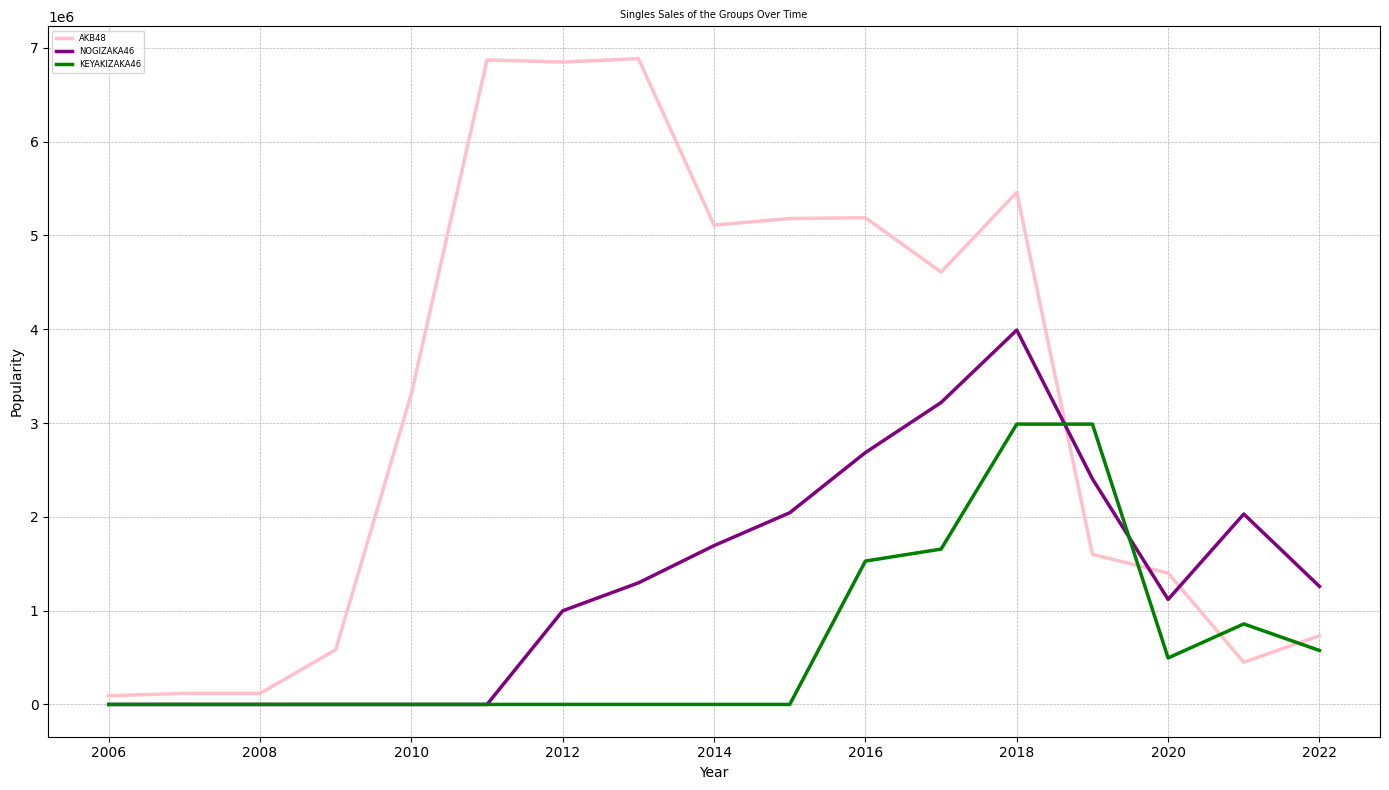Goal: Find correlations between brand loyalty in the context of a consumer-driven subculture such as j-idol culture. Leveraging an analytical approach can help us understand the dynamics that cause certain groups to rise or fall in popularity. By doing so, we can propose an optimal strategy to maintain relevance within the attention market and navigate trends adeptly, while also identifying aggressive techniques for mantaining control of your current status. In this study, the performance of three historically relevant groups will be compared: Nogizaka46, Keyakizaka46 (Now Sakurazaka46) and AKB48.
Introduction
In mid-2023, the J-pop group BokuAo was unveiled by Aki-P1 as the official rival of Nogizaka46. Initially, I believed that BokuAo wouldn’t surpass Nogizaka46. However, a realization dawned upon me: when you are at the top, you can only go down. This prompted me to closely observe every decision made for the group since the end of what we can term the Golden Age of Nogizaka.
Drawing parallels to 2011, during AKB48’s zenith, Akimoto Yasushi announced Nogizaka46 as a rival group. Their primary objective was to outperform AKB (and they succeeded). Yet, they weren’t adversaries. Nogizaka often collaborated with AKB, be it through TV appearances or musical ventures. This symbiotic relationship saw Nogizaka’s dependence on AKB, even as AKB grappled with its own decline.
From a strategic standpoint, if the intention was to elevate a group to the top spot, even at the cost of dethroning your own group, then promoting Nogizaka alongside AKB makes sense. But if the goal was to retain AKB’s supremacy, these decisions appear counterintuitive, if not illogical.
Starting Hypotheses
The Attention Economy and Brand Identity
Attention is a limited resource, so even the remote recognition of relevancy or quality in another group should be understood as diluting part of the attention you have hold of as a courtesy. This issue is even more attenuated when the group you are supporting has a large amount of members, therefore being able to reach a broader amount of your own community, to Nogizaka only 46 members (two less than AKB48’s maximum) was enough to migrate a robust amount of attention to itself. Though, this is not always a problem. See sister groups. In special we can talk about Nogizaka’s first Sister Group, Keyakizaka46. Keyaki was designed to occupy the attention that Nogizaka46 couldn’t reach. While Nogizaka was refined and ellegant, Keyakizaka was a derivative group composed of rebelious teenagers, a fairly distinct concept from Nogizaka, therefore they were able to introduce more people to the collection they belonged to, also known as Sakamichi Series.
Nogizaka46 and Keyakizaka46 had good synergy and even if there was an overlap, Keyakizaka was naturally attracting fans diferente parts of the community, which was fairly damageless to the communities. From now on we’ll call those brief descriptions of the fundamental characteristics of a group as their “brand identity”. My main hypothese is that this brand identity is what mainly drives the brand’s attractiveness of new attention (people) to the group, while also being the one responsible for keeping fans in the community as time passes. A good balance between those two would be the most adequate way of promoting a group and mantaining a good volume of fans, as achieving a long-term success for any brand relies on both building and sustaining strong brand loyalty.
Data
Here I will be sharing and consolidating my exploratory analysis as I move on with the project. Ideally this will be reorganized in the future as a proper, clean and concise post, but for now read at your own risks and take the next insights with a bit of skepticism.
In most of those analysis we’ll be comparing AKB48, Nogizaka46 and Keyakizaka46/Sakurazaka46 (We’ll treat this one as a single thing) to identify the impact of adjascent groups and also noticing how much they differ based on a similar or different brand identity.
Yearly Growth Rate
Using anual sales performance, we can attempt to calculate the yearly growth rate of each group and see if the impact of it was felt by the other groups or not. This is a good start to pinpoint moments of great change in the group’s performance, so we can do a data-driven analysis.
Here is the final table:
| Year | AKB48_growth_rate | NOGIZAKA46_growth_rate | KEYAKIZAKA46_growth_rate |
|---|---|---|---|
| 2006 | 0.000% | 0.000% | 0.000% |
| 2007 | 27.171% | 0.000% | 0.000% |
| 2008 | -0.179% | 0.000% | 0.000% |
| 2009 | 396.806% | 0.000% | 0.000% |
| 2010 | 468.748% | 0.000% | 0.000% |
| 2011 | 107.263% | 0.000% | 0.000% |
| 2012 | -0.331% | ∞ | 0.000% |
| 2013 | 0.534% | 29.805% | 0.000% |
| 2014 | -25.773% | 30.670% | 0.000% |
| 2015 | 1.363% | 20.701% | 0.000% |
| 2016 | 0.171% | 31.381% | ∞ |
| 2017 | -11.164% | 19.870% | 8.347% |
| 2018 | 18.443% | 23.990% | 80.461% |
| 2019 | -70.696% | -39.747% | 0.000% |
| 2020 | -12.500% | -53.441% | -83.420% |
| 2021 | -67.885% | 81.303% | 73.204% |
| 2022 | 63.061% | -38.004% | -32.990% |

Footnotes
Bibliography
-
Aki-P, or Akimoto Yasushi is the founder of AKB48 and of it’s own official rival, Nogizaka46. In 2023 he announced Nogizaka46’s official rival group, the J-pop group Boku ga Mitakatta Aozora. He also produced Checkicco and Onyanko Club. ↲
